Volume 7 Issue 4 April, 2017
Autism spectrum disorders continue to puzzle clinicians as well as researchers. Exact etiopathogenesis still remains unknown and diagnosis is based on behavioral observation. As yet there is no definitive treatment for autism. Socio-communicative abnormalities appear earlier than repetitive stereotypic behavior; it is only around three years of age that the clinical picture becomes stable. Often there is delay in diagnosis due to absence of typical symptoms or non-availability of trained clinicians and hence delay in interventions. There are no biomarkers available in routine clinical practice for the diagnosis of autism. This continues to hinder progress in clinical care and research. It also provides a fertile ground for myths and misconceptions. Parents continue to seek cure of this seemingly mysterious disorder and clinicians remain clueless! Neuroimaging studies have documented abnormalities in neural structure, function and connectivity in the brain with autism present even before birth. Initially, the affected brain is larger than typically developing brain with maximum differences apparent in the frontal and temporal regions. The cause of enlarged brain is understood to be due to increased cortical area thickness and cortical area hyperexpansion. Recent neuroimaging findings reported in ‘Nature’ has discussed cortical area hyperexpansion to be evident as early as six to twelve months of life. These MRI scan findings were reported from brains of high risk infants (those diagnosed with autism at 24 months of age). These neuroimaging findings have ushered a new era of a biological diagnosis of autism much more accurate and earlier than conventional behavioral diagnosis which would mean earlier introduction of intervention measures.

AIIMS, Bubaneshwar (Odisha)





